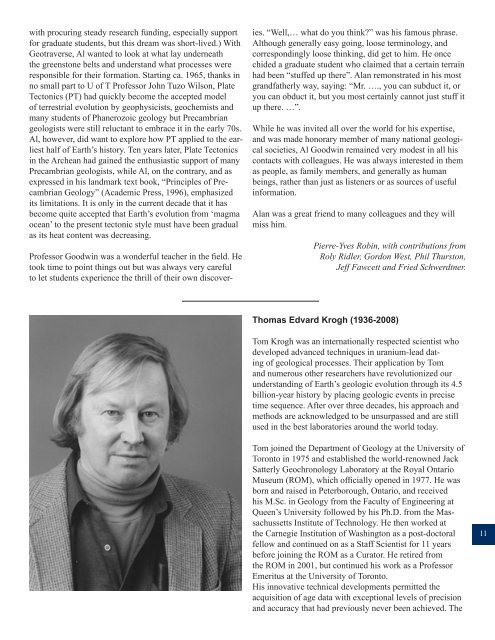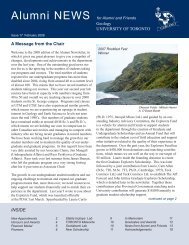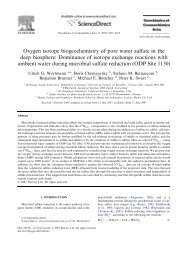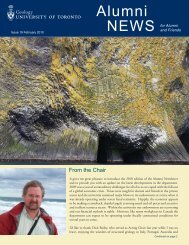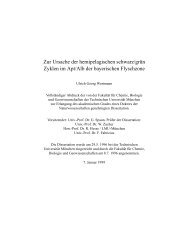Alumni News - Department of Earth Sciences, University of Toronto
Alumni News - Department of Earth Sciences, University of Toronto
Alumni News - Department of Earth Sciences, University of Toronto
You also want an ePaper? Increase the reach of your titles
YUMPU automatically turns print PDFs into web optimized ePapers that Google loves.
with procuring steady research funding, especially support<br />
for graduate students, but this dream was short-lived.) With<br />
Geotraverse, Al wanted to look at what lay underneath<br />
the greenstone belts and understand what processes were<br />
responsible for their formation. Starting ca. 1965, thanks in<br />
no small part to U <strong>of</strong> T Pr<strong>of</strong>essor John Tuzo Wilson, Plate<br />
Tectonics (PT) had quickly become the accepted model<br />
<strong>of</strong> terrestrial evolution by geophysicists, geochemists and<br />
many students <strong>of</strong> Phanerozoic geology but Precambrian<br />
geologists were still reluctant to embrace it in the early 70s.<br />
Al, however, did want to explore how PT applied to the earliest<br />
half <strong>of</strong> <strong>Earth</strong>’s history. Ten years later, Plate Tectonics<br />
in the Archean had gained the enthusiastic support <strong>of</strong> many<br />
Precambrian geologists, while Al, on the contrary, and as<br />
expressed in his landmark text book, “Principles <strong>of</strong> Precambrian<br />
Geology” (Academic Press, 1996), emphasized<br />
its limitations. It is only in the current decade that it has<br />
become quite accepted that <strong>Earth</strong>’s evolution from ‘magma<br />
ocean’ to the present tectonic style must have been gradual<br />
as its heat content was decreasing.<br />
Pr<strong>of</strong>essor Goodwin was a wonderful teacher in the field. He<br />
took time to point things out but was always very careful<br />
to let students experience the thrill <strong>of</strong> their own discoveries.<br />
“Well,… what do you think?” was his famous phrase.<br />
Although generally easy going, loose terminology, and<br />
correspondingly loose thinking, did get to him. He once<br />
chided a graduate student who claimed that a certain terrain<br />
had been “stuffed up there”. Alan remonstrated in his most<br />
grandfatherly way, saying: “Mr. …., you can subduct it, or<br />
you can obduct it, but you most certainly cannot just stuff it<br />
up there. …”.<br />
While he was invited all over the world for his expertise,<br />
and was made honorary member <strong>of</strong> many national geological<br />
societies, Al Goodwin remained very modest in all his<br />
contacts with colleagues. He was always interested in them<br />
as people, as family members, and generally as human<br />
beings, rather than just as listeners or as sources <strong>of</strong> useful<br />
information.<br />
Alan was a great friend to many colleagues and they will<br />
miss him.<br />
Pierre-Yves Robin, with contributions from<br />
Roly Ridler, Gordon West, Phil Thurston,<br />
Jeff Fawcett and Fried Schwerdtner.<br />
Thomas Edvard Krogh (1936-2008)<br />
Tom Krogh was an internationally respected scientist who<br />
developed advanced techniques in uranium-lead dating<br />
<strong>of</strong> geological processes. Their application by Tom<br />
and numerous other researchers have revolutionized our<br />
understanding <strong>of</strong> <strong>Earth</strong>’s geologic evolution through its 4.5<br />
billion-year history by placing geologic events in precise<br />
time sequence. After over three decades, his approach and<br />
methods are acknowledged to be unsurpassed and are still<br />
used in the best laboratories around the world today.<br />
Tom joined the <strong>Department</strong> <strong>of</strong> Geology at the <strong>University</strong> <strong>of</strong><br />
<strong>Toronto</strong> in 1975 and established the world-renowned Jack<br />
Satterly Geochronology Laboratory at the Royal Ontario<br />
Museum (ROM), which <strong>of</strong>ficially opened in 1977. He was<br />
born and raised in Peterborough, Ontario, and received<br />
his M.Sc. in Geology from the Faculty <strong>of</strong> Engineering at<br />
Queen’s <strong>University</strong> followed by his Ph.D. from the Massachussetts<br />
Institute <strong>of</strong> Technology. He then worked at<br />
the Carnegie Institution <strong>of</strong> Washington as a post-doctoral<br />
fellow and continued on as a Staff Scientist for 11 years<br />
before joining the ROM as a Curator. He retired from<br />
the ROM in 2001, but continued his work as a Pr<strong>of</strong>essor<br />
Emeritus at the <strong>University</strong> <strong>of</strong> <strong>Toronto</strong>.<br />
His innovative technical developments permitted the<br />
acquisition <strong>of</strong> age data with exceptional levels <strong>of</strong> precision<br />
and accuracy that had previously never been achieved. The<br />
11


